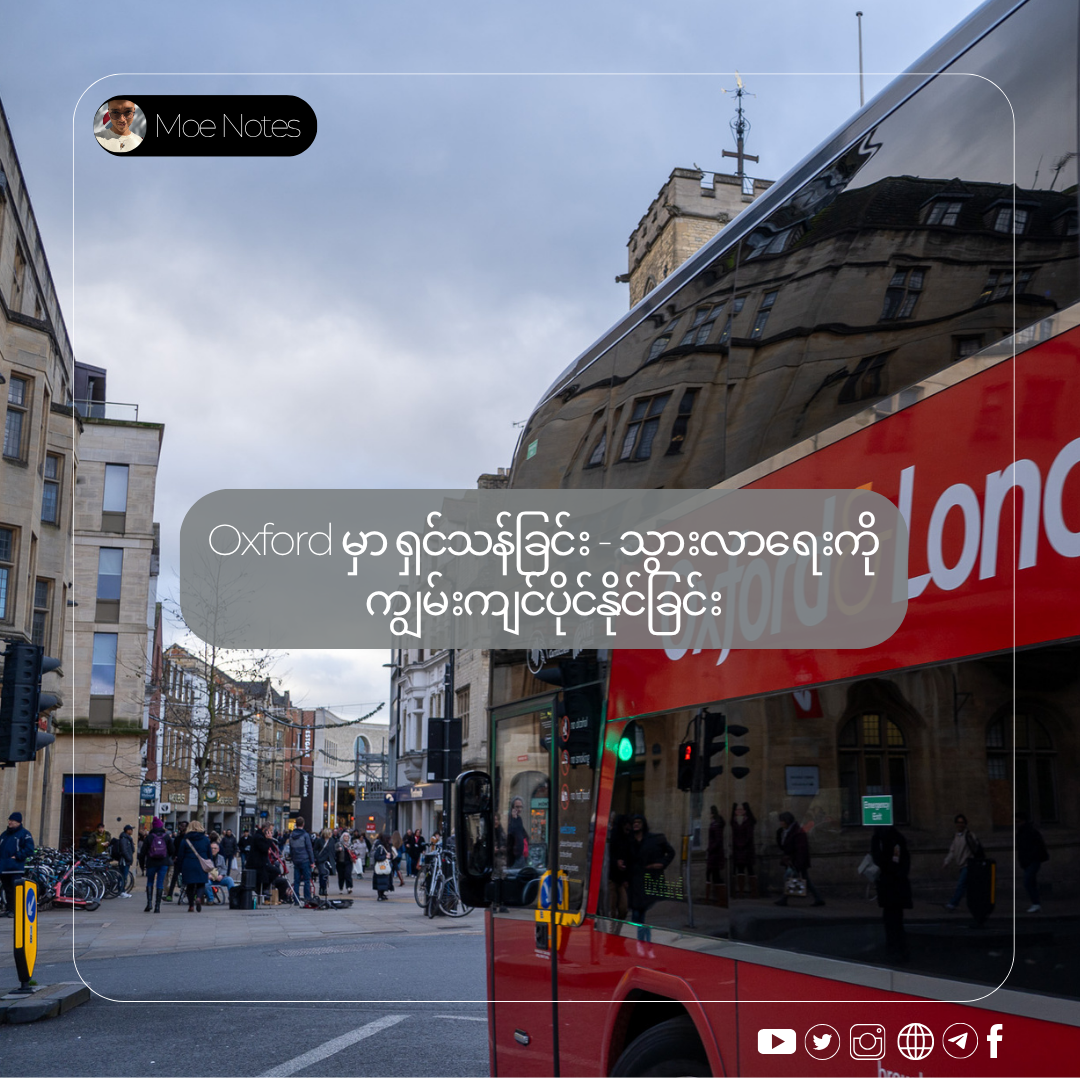Surviving in Oxford: Mastering Transportation

(Read Time: 12 Minutes)
This article is also available in [Burmese]
Before you arrive in Oxford, your thoughts will likely be filled with images of classrooms, ancient buildings, and sprawling parks. But after you set foot in this city, the most critical strategic decision you’ll have to make every single day is, “How am I getting to class today?”
This guide is the real-world manual you won’t find in the university prospectus. Oxford’s transportation system is unlike that of a major metropolis like London, with its complex web of underground trains. Oxford is a world of bicycles and pedestrians. I’m going to break down each mode of transport in this city, complete with costs, advantages, and disadvantages, all framed by my year of hands-on experience.
Method 1: Walking (The Foundation)
Cost | Availability | Requirements |
|---|---|---|
£0 | 24/7 | None |
Analysis: Walking is the best way to truly “feel” and experience Oxford. You can walk from Wheatley on the eastern edge of the city to Botley on the western edge in about three hours. The sidewalks are well-maintained, and with streetlights everywhere, it’s safe to walk at night. I’ve personally walked to the outskirts of the city late at night and have never had any problems.
Pros:
- Completely free and available at any time.
- It’s healthy and allows you to discover the city’s beautiful hidden alleyways.
Cons:
- It requires a significant amount of time and is impractical for urgent matters.
- Oxford’s cold and damp weather can quickly turn a pleasant walk into a miserable experience.
Method 2: Private Bicycle (The King of Student Transport)
Cost | Availability | Requirements |
|---|---|---|
£150 - £400+ (Initial) | 24/7 | Resilience to the weather |
Analysis: If you want to escape the frustration of waiting for a bus or being stuck in traffic, a bicycle is your best friend. Oxford has excellent cycling infrastructure, and the majority of students rely on bikes as their primary mode of transport.
My Real-World Cost Breakdown:
- Essentials:
- Bicycle (a good second-hand one): £150
- A high-quality D-Lock (non-negotiable): £40
- Front and Rear Lights (legally required): £20
- Helmet: £35
- Total Initial Cost: ~£245
- Strongly Recommended Accessories:
- Quadlock Phone Holder + Case: £70 (a lifesaver for Google Maps)
- Cycling gloves, cap, and ski mask: ~£50 (for the winter months)
Pros:
- Saves time and offers complete flexibility to go wherever you want, whenever you want.
- You will save a significant amount of money on bus fares in the long run.
Cons:
- Bike Theft: Bike theft in Oxford is practically a local tradition. If you don’t use a high-quality D-Lock or leave your bike outside overnight for an extended period, it’s unlikely to be there in the morning. Even my detachable lights have been stolen.
- Maintenance: You can expect to deal with minor repairs, such as a flat tire or a slipped chain, about once a month.It’s physically demanding and exposes you to the elements. You will need suitable clothing, a reliable backpack, and other essential accessories. Carrying large or heavy items is also tricky.
Method 3: The Bus (The Reliable Workhorse)
Cost | Availability | Requirements |
|---|---|---|
£2-3 (Single Trip) | ~6 AM - 12 AM | Patience for waiting |
Analysis: Oxford’s double-decker buses are the lifeblood of the city. For most students, they are an essential part of daily life. By downloading the “Oxford Bus” app, you can track live locations and time your arrival at the stop perfectly.
Price Details:
- A single trip costs around £2 if you can show a student card.
- A weekly unlimited pass costs around £19 and offers much better value.
Pros:
- It protects you from the weather and is a comfortable way to travel.
- It has an extensive network that covers most parts of the city.
Cons:
- Punctuality: The time shown in the app and the actual arrival time can differ by 10-15 minutes. It’s always best to be at the stop 5 minutes early.
- Overcrowding: During peak morning hours, a bus might be completely full and will drive past your stop without stopping. You could wait another 20 minutes for the next one.
- Limited Schedule: There are no buses after midnight, which can be inconvenient for students who wish to study late at the library.
- It doesn’t cover every route, and some may not be convenient for your journey.
Method 4: E-Scooter (The Modern Wildcard)
Cost | Availability | Requirements |
|---|---|---|
~£0.20/minute | 24/7 | UK Provisional Driving Licence |
Analysis: The officially sanctioned VOI e-scooters in Oxford are a fast and fun option, but they come with their own set of challenges.
My Personal Story: I used to rent a scooter on a monthly subscription for £65. However, after about a month, my accommodation informed me that charging them inside the building was prohibited due to fire safety concerns. Since there are no dedicated charging stations for private e-scooters or e-bikes, I had to cancel the plan and buy a bicycle. This is a crucial lesson: always read your Tenancy Agreement carefully.
Pros:
- Faster than the bus and can easily navigate through traffic.
- Effortless to ride and requires no physical exertion.
Cons:
- Expensive: If used daily, the cost can quickly add up to be much more than a bus pass.
- Availability: There may not be a scooter available at a nearby stand when you need one.
- Legal Requirement: You must have a UK Provisional Driving Licence to use them legally.
Methods 5 & 6: Taxi and Private Car (The Emergency & The Evolving Need)
- Taxi/Uber: Exactly as you’d expect. Services like Uber and Royal Cars are available, but they are costly. They are not a viable option for daily student travel and should be reserved for late-night emergencies or when transporting heavy luggage.
- Private Car: It’s essential to look at this from two different perspectives:
- For a student living within Oxford, A car is a financial trap. The costs of purchasing the vehicle, getting a license, insurance, and parking are enormous, and driving within the city is a nightmare. For a student whose life is primarily based in Oxford, a car is an unnecessary burden.
- For a professional or someone with a changing lifestyle: Once you graduate and start working, or if you need to travel frequently to other cities, the value of a car increases dramatically. It becomes essential to reach rural areas not served by public transport, expand your potential work radius beyond what’s reachable by bike, or transport professional equipment, as I often have to do for my film work. So, a car isn’t inherently “bad”; its value depends entirely on “when and where” you need to use it.
Method 7: Inter-City Travel
One of the significant advantages of living in Oxford is its excellent connectivity to other major cities.
- Oxford Tube (The Easiest Way to London): This is a 24/7 express coach service between Oxford and London. The buses are comfortable and have Wi-Fi. They depart from Gloucester Green Bus Station in central Oxford and arrive directly at Victoria Coach Station in central London.
- Cost: A return ticket is around £20, which is excellent value.
- Duration: The journey takes between 1.5 and 2.5 hours, depending on traffic.
- Train (To the Rest of the UK): From Oxford Railway Station, you can travel directly or with one change to most major UK cities, including London, Birmingham, and Manchester.
- Cost: Train tickets can be expensive. It is essential to buy a “16-25 Railcard” for £30 a year. It gives you a 33% discount on all rail fares, so it pays for itself after just a couple of trips.
- Tip: Depending on your destination, there may be cheaper options available. It’s always a good idea to buy your tickets at the railway station.
How Does a Car Become Important Here? If you’re traveling to a city with excellent public transport, like London, you don’t need a car. But if you want to explore beautiful rural areas like the Cotswolds, visit small towns not on the train line, or, like me, carry a lot of filming equipment, owning a car provides true freedom.
My Ultimate Choice for Oxford
Without a doubt, for daily life within Oxford, the bicycle is the clear winner. Despite the initial investment and maintenance, the freedom, punctuality, and long-term cost savings it provides are unmatched. The ability to go wherever I want, whenever I want, without waiting for anyone, whether it’s raining or sunny, is one of the most valuable freedoms of student life.
In Conclusion, the mode of transport you choose will define how you experience Oxford. This isn’t just about getting from one place to another; it’s a daily strategic decision about how you manage your most valuable resources: your time and your money.



